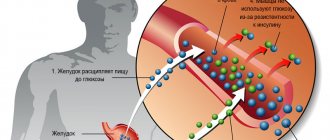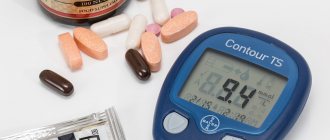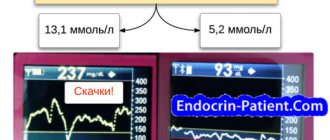Medical certificate
Diabetes mellitus is a disease that causes high blood sugar levels. This condition develops for two main reasons:
- deficiency or complete absence of insulin (type I diabetes);
- tissue insensitivity to insulin (type II diabetes).
Against the background of increased glucose levels in the blood, complications arise from the central nervous system and blood vessels. The initial manifestation of the disease is numbness and tingling in the fingers. Subsequently, the person stops feeling pain. Therefore, people with diabetes often do not notice abrasions and scratches on the skin and injuries on the feet.
Hyperglycemia is always accompanied by impaired vascular patency in the extremities. Gradually this leads to multiple hemorrhages and thrombosis. “Sweet” blood is a favorable environment for the life of bacteria. Therefore, any infectious diseases in people with diabetes are extremely difficult, and wounds take a long time to heal.
As a result of the listed features of the disease, trophic ulcers may appear on the feet. They are very difficult to treat. If treatment is neglected, diabetic gangrene develops. In most cases, it affects the lower extremities.
Diagnostics
The complication has a pronounced clinical picture, so diagnosing the condition is not difficult.
The surgeon, together with the endocrinologist, determines the severity of the disease
Diagnostic algorithm:
- Examination by a surgeon.
- Consultation with an endocrinologist.
- General blood test (determines the severity of damage to the body).
- Biochemical blood test (glucose level determination, immunogram).
- Blood sampling for sterility (detection of the type of pathological microorganisms).
- Culture of wound contents (the causative agent of infection is identified).
- X-ray examination (will determine the extent of the lesion).
- Angiography (assessment of the condition of blood vessels).
- Dopplerography (determining the blood circulation speed of the affected area).
Main reasons
In people who have had diabetes for more than 5 years, their toes and feet gradually lose sensation. A high concentration of sugar in the blood literally kills nerve endings. At the same time, the elasticity and patency of blood vessels is impaired. Patients with diabetes are at high risk of developing ischemic and infectious gangrene. What is the difference?
In the first case, the pathology is caused by impaired blood supply to tissues, which may be due to damage to arterial vessels. Infectious gangrene develops against the background of active bacterial activity. These may be streptococci and E. coli penetrating into the wound.
Among other causes of the pathological process, doctors note:
- decreased immunity;
- polyneuropathy;
- blockage of blood vessels due to atherosclerosis;
- disturbances in the formation of bone tissue.
Separately, it is necessary to talk about factors that aggravate the course of the disease. These are excess weight, poor-quality or incorrectly selected shoes, smoking. As for the last addiction, scientists cite very interesting facts as proof. Smoking, even in a healthy person, can cause gangrene, but in diabetes mellitus it develops several times more often. Nicotine is known to have a vasodilating effect. On the other hand, under the influence of carbon monoxide, blood vessels lose their elasticity, and their lumen narrows. Therefore, nicotine promotes the formation of blood clots, resulting in gangrenous tissue necrosis.
about the author
My name is Andrey, I have been a diabetic for over 35 years. Thank you for visiting my website about helping people with diabetes.
I write articles about various diseases and personally advise people in Moscow who need help, because over the decades of my life I have seen many things from personal experience, tried many remedies and medicines. In the current 2020, technology is developing very much, people do not know about many things that have been invented at the moment for a comfortable life for diabetics, so I found my goal and help, to the best of my ability, people suffering from diabetes to live easier and happier.
First symptoms
Many patients do not even notice how gangrene begins with diabetes. It's all about loss of sensitivity in the limbs. However, there are so-called precursors of the disorder, by the appearance of which one can judge impending pathological changes in the lower extremities. First of all, this:
- frequent swelling of the legs;
- feeling of tingling and numbness;
- change in skin color;
- foot deformity;
- pain in the calf muscles;
- a feeling of cold spreading to the lower extremities;
- changes in the appearance and structure of nails, fungal infection.
These symptoms most often appear in combination. You should not ignore them; it is better to immediately seek advice from a doctor.
The first signs of gangrene in diabetes
Patients with diabetes have a significantly lower threshold for sensitivity to pain; they do not immediately pay attention to discomfort in the foot area - cuts, abrasions, calluses, cracks. Gradually, a sluggish inflammation occurs, caused by the penetration of infection into the wounds, and an ulcer forms. Further, the process can develop rapidly, and the patient develops diabetic gangrene.
Diabetic nephropathy - you need to slow down the disease in time
Several signs that should alert a patient with diabetes:
- Constantly felt fatigue in the legs;
- Tingling in the feet;
- Numbness of the legs;
- Pain in the leg muscles;
- The color of the foot has changed - it has become bluish or red;
- The foot is cold to the touch.
Detection of such phenomena indicates disorders of peripheral circulation.
What a diabetic should pay attention to so as not to miss the onset of gangrene:
- Constant pain in the legs;
- Dark skin in the affected area (purple or black);
- Copious purulent discharge in the affected area (not always);
- Pulsation in the limb is not palpable;
- High temperature, chills, nausea.
If you notice the above symptoms, you should consult a doctor and undergo a thorough examination.
Varieties of the disease
Gangrene of the lower extremities in diabetes mellitus is usually divided into types depending on the origin. For example, the angiopathic form is caused by dysfunction of blood vessels, and the neuropathic form is caused by damage to nerve tissue. Osteopathic gangrene develops against the background of pathological changes occurring in the bone elements.
According to the nature of the course of gangrene, it can be dry or wet. Each of these forms has certain characteristics.
The development of dry gangrene occurs due to damage to blood vessels and disruption of blood flow in them. The pathological process, as a rule, lasts for several months. During this period, the body manages to adapt to the new state and even develop so-called protective mechanisms. This form of the disease usually spreads to the toes. She does not pose a threat to life. Amputation is performed only for cosmetic or preventive purposes.
Wet gangrene occurs as a result of infection of open wounds by anaerobic bacteria. Rotting areas appear on the skin, which very quickly spread to healthy tissue. The affected area is dark or almost black in color. Hydrogen sulfide gradually accumulates in the subcutaneous space. Therefore, upon palpation you can hear a characteristic sound. Dying tissues emit foul odors. The patient’s health condition is rapidly deteriorating, as cadaveric poison is carried through the body through the bloodstream. The only way to save life is to amputate the limb.
Application of preventive measures
What to do if wounds do not heal well?
You can also use various folk remedies and medicinal herbs. In this case, you should first contact your doctor and find out whether it is possible or not to use this method of alternative medicine, and why the wound does not heal for so long.
A medical specialist will help resolve this issue and tell you about those methods that are not used for diabetes.
Every diabetic should carefully monitor the condition of the skin and take appropriate preventive measures.
The set of measures consists of the following procedures and recommendations:
- To clean the wound from germs and contamination, it is necessary to use ordinary sterile saline solution. Drugs that are often used to treat wounds (hydrogen peroxide, salicylic acid, iodine) are not suitable for diabetics, as they can aggravate the period of epithelization. For patients suffering from ulcers, it is recommended to use vortex (with turbulent fluid movement) baths for the lower extremities.
- Regular cucumber juice is an excellent remedy with an antiseptic effect. It cleanses the skin of microbes that multiply on its surface.
- To avoid the appearance of wounds or ulcers on the lower extremities, it is necessary to make it a rule to monitor the condition of the skin on the legs and other parts of the body daily.
- You should maintain personal hygiene by using household chemicals approved for diabetics (without dyes or odors, with the correct pH level).
- Invest in comfortable underwear, tights or socks for diabetics. In addition, an important aspect is comfortable shoes that will not contribute to the development of calluses and corns. It is better to avoid wearing high-heeled shoes, as normal blood circulation in the lower extremities deteriorates and the load on the legs increases.
- If possible, do not go barefoot.
- Protect your feet from hypothermia and low temperatures.
An important aspect is also to provide the body with the necessary vitamins and mineral complexes. Your doctor can advise you on the best antioxidants to take.
The video in this article will tell you which skin care creams to use for diabetics.
Medical examination
Diagnosing gangrene in diabetes mellitus is not difficult. Before prescribing treatment, the doctor must examine the affected limb. This involves a physical examination. It is important for a specialist to know when the first symptoms of the disorder appeared and what the patient did to eliminate them. Particular attention is paid to skin color, the presence of an unpleasant odor, and the presence of pain symptoms.
Diagnosis of gangrene in diabetes mellitus also includes testing. The patient must donate blood, a tissue sample from the affected area, undergo an MRI and an arteriogram. Based on the results of a comprehensive examination, treatment is prescribed.
Conservative methods of therapy
At the initial stages of the pathological process, patients are recommended to undergo conservative treatment. Typically it has the following goals:
- Compensation for diabetes with blood sugar-lowering drugs and insulin.
- Reducing the load and pressure on the affected limb.
- The use of antibacterial agents to suppress infection and intoxication of the body.
- Restoring immunity through vitamin therapy.
Conservative treatment of gangrene in diabetes mellitus leads to positive dynamics, but not always. If this approach turns out to be ineffective, radical methods are resorted to. They will be discussed in more detail below.
Treatment at home
Unconventional methods of eliminating the disease are recommended to be used only at the initial stage of its development. You should first consult your doctor. If such therapy does not produce results over a certain period of time, you need to tell your doctor about it. A specialist will be able to select alternative options for eliminating gangrene in diabetes mellitus.
At home, to treat pathology, traditional healers recommend making various lotions. For example, a red clay mask is considered an effective remedy. To prepare it, you need to mix dry clay and finely chopped raw onion in equal proportions. Then you should add a small amount of vinegar. It is recommended to apply the resulting mixture to the affected area until completely dry.
In the early stages, lotions based on yogurt or clove oil are quite effective. Regular gauze must be moistened in liquid and applied to the foot. Regular repetition of such procedures allows you to quickly eliminate gangrene.
Prevention methods
You can prevent the development of gangrene in diabetes mellitus if you follow the basic rules of prevention. For this disease, doctors recommend:
- Fight bad habits that lead to impaired blood circulation in the vessels.
- Maintain hygiene of the limbs, use creams to moisturize the skin and prevent cracks.
- Wear only comfortable shoes made from quality materials.
- Treat wounds and cuts promptly.
- If your general health worsens due to diagnosed diabetes, you should immediately consult a doctor.
By following the presented preventive measures, diabetic patients can avoid the development of complications and even improve their quality of life. Otherwise, gangrene and limb amputation cannot be avoided.
Features of neuropathic complications
If a person develops diabetic neuropathy, the nerve endings die, after which they first partially and then completely lose sensitivity. When a person has a “sweet” disease, this phenomenon occurs often; a characteristic sign is the formation of ulcers containing pus. A sick person simply cannot feel the resulting microtraumas. To prevent this condition, it is necessary to regularly monitor the level of glucose in the bloodstream and closely monitor changes in blood pressure. Under the influence of such factors, the vascular walls rapidly weaken, and the nerve fibers are damaged.
When a person develops neuropathy, the foot is affected because the majority of the stress is concentrated there. As a result, numerous deep ulcers are formed that do not heal; they reach the tendons and affect the skeletal system. This condition can be treated in different ways, but camphor oil helps most effectively.











